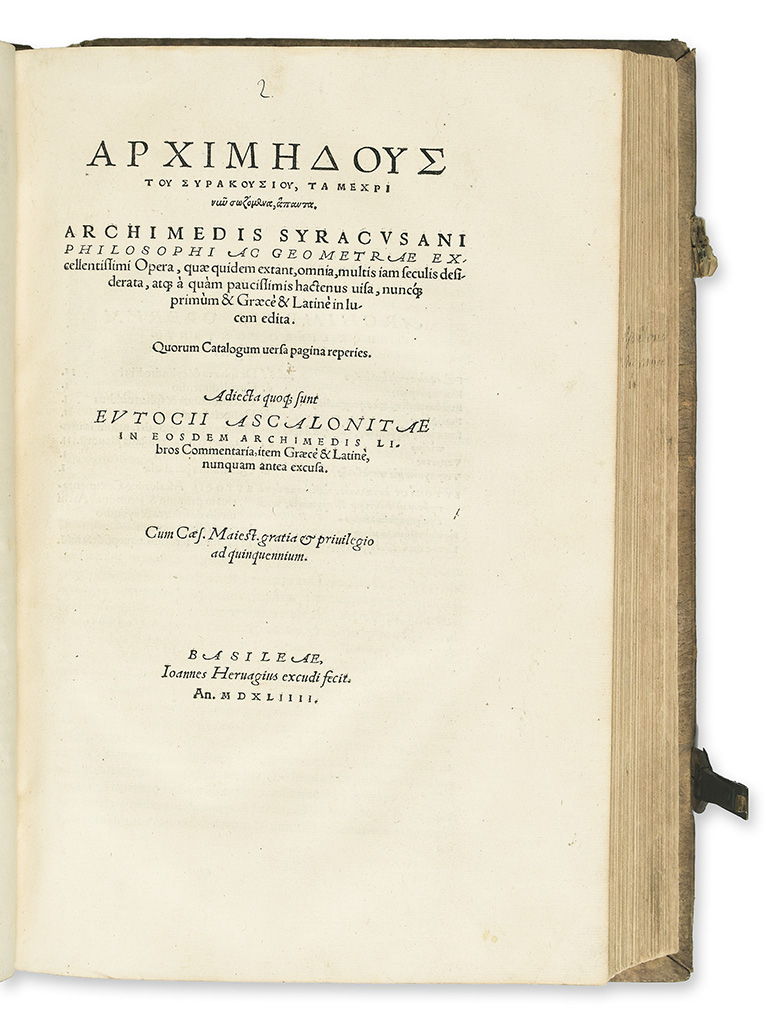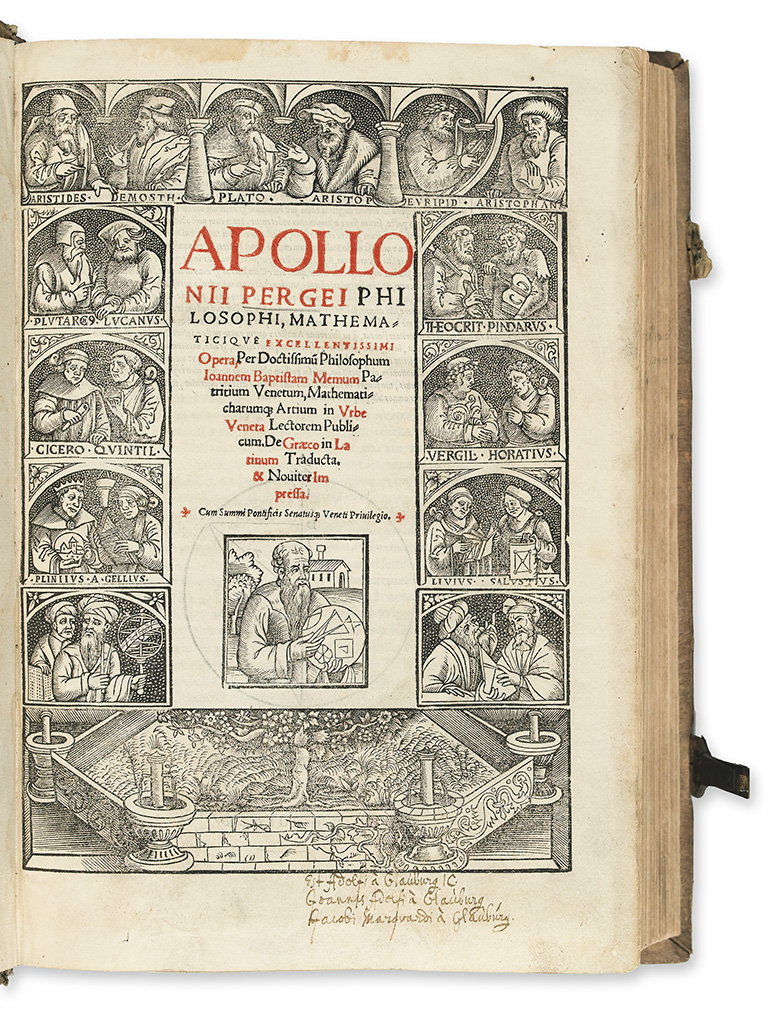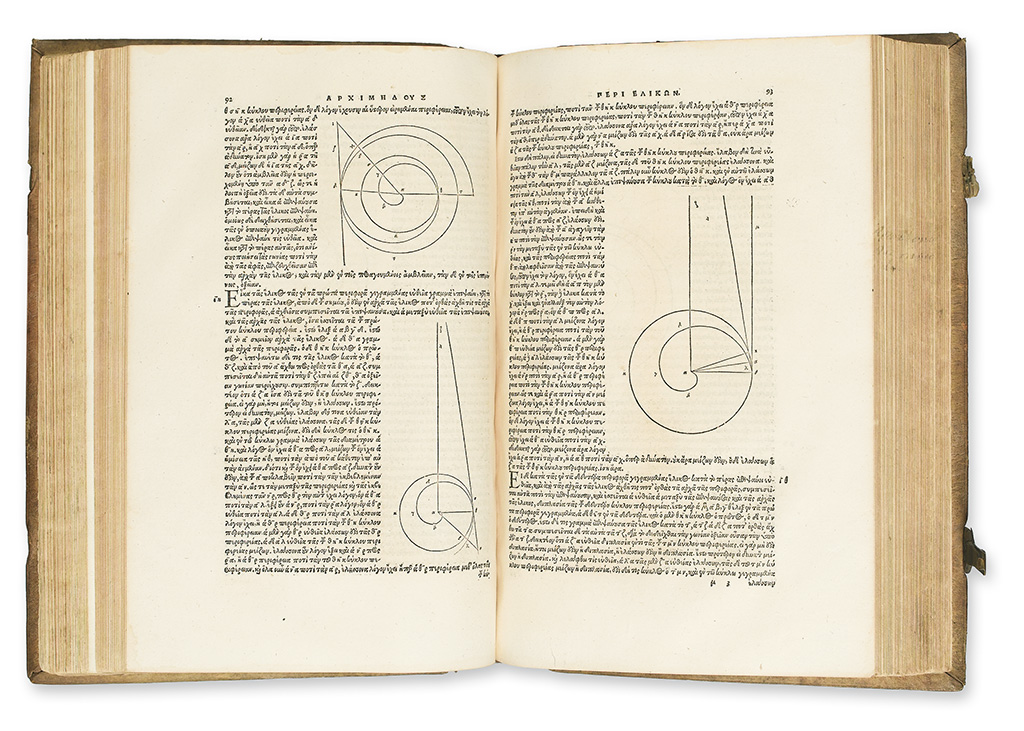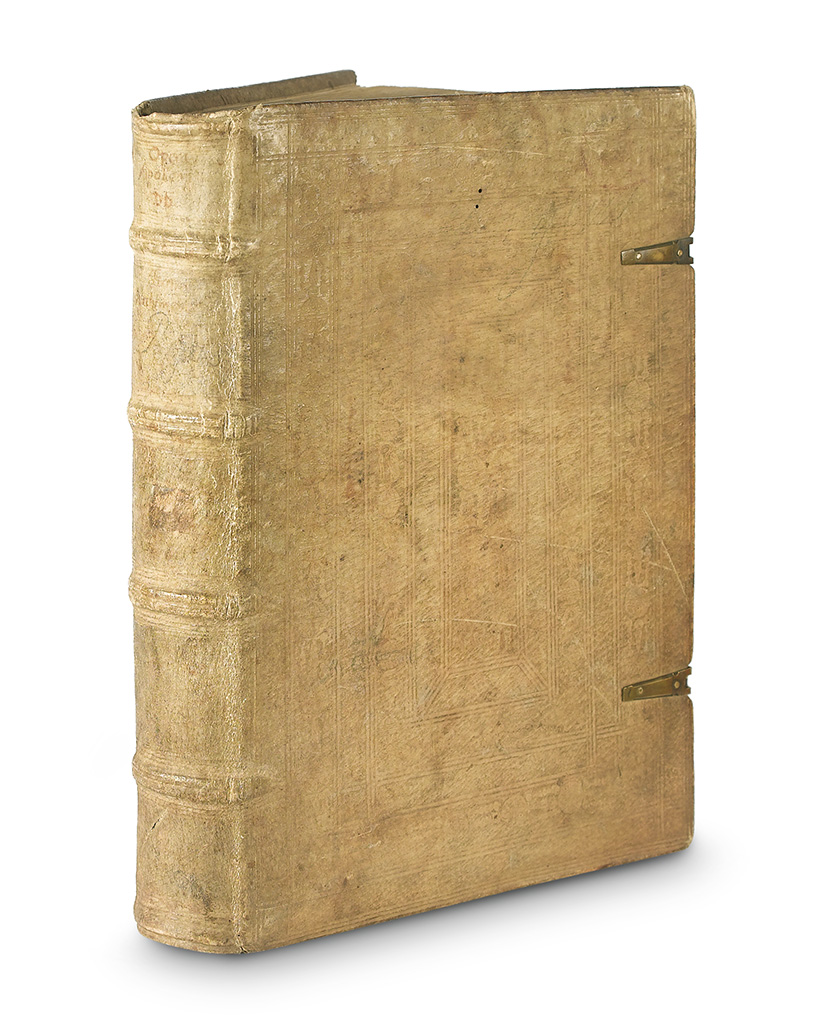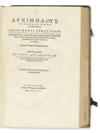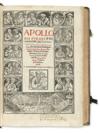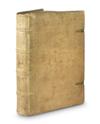Sale 2343 - Lot 8
Price Realized: $ 75,000
Price Realized: $ 93,750
?Final Price Realized includes Buyer’s Premium added to Hammer Price
Estimate: $ 30,000 - $ 50,000
ARCHIMEDES. Opera omnia . . . Adjecta quoque sunt Eutocii Ascalonitae in eosdem Archimedis libros commentaria. Greek text with Latin translation by Jacopo da Cremona; edited by Thomas Gechauff. [8], 139, [1]; [4], 65, [3]; [8], 163, [1]; 68, [1] (of [3]) pages, including register/colophon leaf at end; lacks last leaf, blank except for printer's device on verso. 4 parts in one volume. bound after: APOLLONIUS of Perga. Opera. Latin translation by Giovanni Battista Memmo. Title in red and black within woodcut historiated border depicting ancient Greek and Roman philosophers and authors. 88, [2] leaves, including final blank. Together, 2 volumes in one, both with woodcut text diagrams throughout. Folio, 312x212 mm, contemporary pigskin over wooden boards, blind-tooled to panel design formed by concentric ornamental rolls, brass catches, one catch (of 2); generally bright internally, with dampstaining in upper inner corners at beginning and end of volume and along top edges in between, few tiny wormholes through blank upper and outer margins in second half of the volume. 17th-century ownership inscription of the Glauburg family of Frankfurt ("Est Adolfi à Glauburg IC, Joannis Adolfi à Glauburg, Jacobi Marquardi à Glauburg") on the title of Apollonius; unidentified early 20th(?)-century woodcut bookplate on verso. This lot is not from the Gutzwiller collection. Basel: Johann Herwagen, 1544; (Venice: Bernardino Bindoni for Giovanni Battista Memmo, 1537)
Additional Details
handsome sammelband, unrestored, combining the writings of the greatest mathematician of the ancient world with one of the most influential texts of early Greek geometry.
first edition in the original greek of works by Archimedes (287-212 B.C.) on measurement of the circle, spirals, quadrature of the parabola, conoids and spheroids, and the possibility of numbering the sands, with the addition of the 6th-century commentary by Eutocius of Ascalon. "Archimedes--together with Newton and Gauss--is generally regarded as one of the greatest mathematicians the world has ever known . . . His influence began to take full effect only after the publication of this first printed edition, which enabled Descartes, Galileo, and Newton in particular to build on what he had begun" (PMM). Adams A1531; BEA, pages 56-57; DSB I, 213-31; Hoffmann I, 228; Norman 64; Printing and the Mind of Man 72; Sarton I, 169-72.
first edition of Books 1-4 of Apollonius of Perga's Conics, "one of the greatest scientific books of antiquity" (Sarton), dating from the early 2nd century B.C., the original Greek text of which did not appear until 1710. Books 5-7, surviving only in Arabic, were first published in Latin translation in 1661. "In astronomy, Ptolemy used Apollonius as his authority on epicycles and eccentrics to account for the apparent motions of the planets . . . In mathematics, Apollonius's Conics give us the concepts and nomenclature for ellipse, parabola, and hyperbola . . . Apollonius found a new generalized way to describe the properties of all three conic sections, and went on to discuss a number problems connected with them. The Conics . . . were studied by Arab astronomers and by Johannes Kepler, Rene Descartes, Edmund Halley, and Isaac Newton"--BEA, pages 51-52. DSB I, 179-93; Hoffmann I, 205; Sarton I, 173-75.
first edition in the original greek of works by Archimedes (287-212 B.C.) on measurement of the circle, spirals, quadrature of the parabola, conoids and spheroids, and the possibility of numbering the sands, with the addition of the 6th-century commentary by Eutocius of Ascalon. "Archimedes--together with Newton and Gauss--is generally regarded as one of the greatest mathematicians the world has ever known . . . His influence began to take full effect only after the publication of this first printed edition, which enabled Descartes, Galileo, and Newton in particular to build on what he had begun" (PMM). Adams A1531; BEA, pages 56-57; DSB I, 213-31; Hoffmann I, 228; Norman 64; Printing and the Mind of Man 72; Sarton I, 169-72.
first edition of Books 1-4 of Apollonius of Perga's Conics, "one of the greatest scientific books of antiquity" (Sarton), dating from the early 2nd century B.C., the original Greek text of which did not appear until 1710. Books 5-7, surviving only in Arabic, were first published in Latin translation in 1661. "In astronomy, Ptolemy used Apollonius as his authority on epicycles and eccentrics to account for the apparent motions of the planets . . . In mathematics, Apollonius's Conics give us the concepts and nomenclature for ellipse, parabola, and hyperbola . . . Apollonius found a new generalized way to describe the properties of all three conic sections, and went on to discuss a number problems connected with them. The Conics . . . were studied by Arab astronomers and by Johannes Kepler, Rene Descartes, Edmund Halley, and Isaac Newton"--BEA, pages 51-52. DSB I, 179-93; Hoffmann I, 205; Sarton I, 173-75.
Exhibition Hours
Exhibition Hours
Aliquam vulputate ornare congue. Vestibulum maximus, libero in placerat faucibus, risus nisl molestie massa, ut maximus metus lectus vel lorem.



